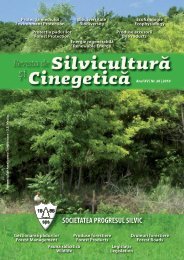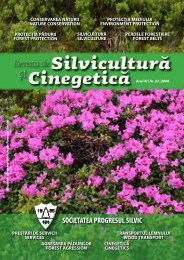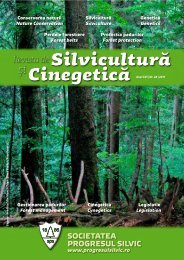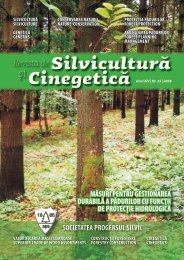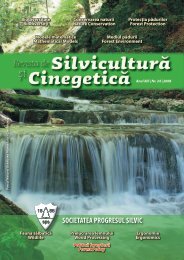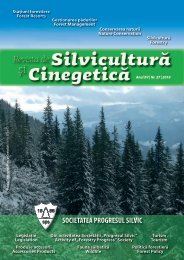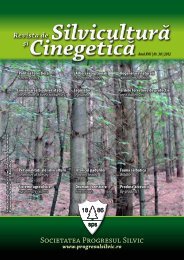Silviculture and Cinegetics Review - Societatea Progresul Silvic
Silviculture and Cinegetics Review - Societatea Progresul Silvic
Silviculture and Cinegetics Review - Societatea Progresul Silvic
You also want an ePaper? Increase the reach of your titles
YUMPU automatically turns print PDFs into web optimized ePapers that Google loves.
FORESTRY BELTS SILVICULTURE AND CINEGETICS REVIEW XVII/30/2012<br />
Their studies have been marginalized, agronomists<br />
considering that it is the job of the foresters, <strong>and</strong><br />
foresters in their turn dealing with forests, <strong>and</strong> less with<br />
isolated trees on grassl<strong>and</strong>s, etc.<br />
While in Mediterranean countries strongly affected by<br />
periods of excessive heat <strong>and</strong> dryness, foresters <strong>and</strong><br />
agronomists have already taken concrete steps with<br />
awareness <strong>and</strong> generalization of the traditional<br />
agroforestry systems like the Spanish dehesa; in our<br />
country these systems have not yet been taken into<br />
account to extend them in order to prevent the negative<br />
effects of global warming. Therefore, it is considered<br />
necessary an inventory of all agroforestry systems in<br />
our country, by mixed teams, agronomists <strong>and</strong> foresters,<br />
followed by study of their functionality as a means to<br />
protect the grass carpet, arable crops, grazing animals,<br />
trees, fruit trees, etc., economical source of feed, animal<br />
products, cereals, fruits, wood, l<strong>and</strong>scape aesthetics <strong>and</strong><br />
others. After establishing the main functions of<br />
agroforestry systems we can move to the modernization<br />
of the maintenance <strong>and</strong> capitalization works of these<br />
complex resources, which can better adapt to future<br />
climate change.<br />
Photo 5.Grassl<strong>and</strong> with oaks<br />
Thus, the agroforestry system together with the<br />
afforestation of degraded l<strong>and</strong>, installation of protection<br />
forest belts, exp<strong>and</strong>ing irrigation <strong>and</strong> other measures,<br />
can help to complement the specific measures to<br />
combat aridity <strong>and</strong> desertification which will affect both<br />
pastoral <strong>and</strong> livestock fund.<br />
A complex agroforestry system could more easily pass a<br />
global warming regime than the current system with<br />
pastures <strong>and</strong> animals without trees, simple arable crops<br />
<strong>and</strong> others.<br />
4. Conclusions<br />
- In Romania, at an increase of the average air<br />
temperature of only 3 0 C by year 2070, according to<br />
prognosis, more than 30 % of the country will be<br />
affected by desertification <strong>and</strong> about 38% of increased<br />
aridity, which will encompass all our plains, up to 85 %<br />
of the hills <strong>and</strong> almost 20 % of the pre-mountain <strong>and</strong><br />
low mountain area;<br />
- The prognosis of global warming by 3 0 C in our<br />
country will create major disturbances in the<br />
distribution by altitude of the vegetation floors in the<br />
Carpathians, in the sense that the upper limit of the<br />
spruce will increase with 600 m, reaching 2400 m<br />
altitude, <strong>and</strong> the upper subalpine (mountain pine) <strong>and</strong><br />
alpine floors will slowly disappear. The maximum<br />
productivity of the forests <strong>and</strong> natural grassl<strong>and</strong>s located<br />
now at the 1000 – 1200 m raise to 1600 – 1800 m<br />
altitude;<br />
- The possibilities of increasing production of the<br />
grassl<strong>and</strong>s that will benefit from heat <strong>and</strong> humidity<br />
higher than at present, are seriously diminished by<br />
physical - chemical properties of the soil that will<br />
change more slowly than the climate, by the difficult<br />
access conditions due to relief energy, etc., reasons for<br />
which will be necessary to develop other related<br />
activities such as agroturism;<br />
- In Spain, with its Mediterranean climate, since the<br />
Neolithic an agroforestry system called "dehesa" has<br />
spread, with an oak trees density of 20-100 per hectare,<br />
150-300 years old, where every 10-15 years regular<br />
training cuts are made to the crown, cork is harvested<br />
every 9-12 years, the average acorn production is 200-<br />
600 kg/ ha /year, <strong>and</strong> there is the direct tree production,<br />
plus it provides protection for the grassy carpet lawns,<br />
shade for crops <strong>and</strong> grazing animals;<br />
- The extensive crop yields made in the dehesa<br />
system are of 1-3 t / ha grain to grain straw, 1-3 t / ha<br />
DM to natural meadows <strong>and</strong> sown with an optimal load<br />
0.2 to 0.4 LU / ha cattle, sheep, goats or pigs from 0.4 to<br />
0.6 ha in environmental conditions, maintaining<br />
the l<strong>and</strong>scape, intense sequestration of carbon <strong>and</strong> other<br />
advantages. The Iberian agroforestry is constantly<br />
exp<strong>and</strong>ing <strong>and</strong> improving with funds from the<br />
European Union, <strong>and</strong> is widely considered a viable<br />
solution to prevent desertification <strong>and</strong> aridisation of the<br />
current climate;<br />
- The thermal regime of the air (0-200 cm height) <strong>and</strong><br />
soil (0-150 cm depth) of woody vegetation is<br />
more constant <strong>and</strong> lower by about 2.2 ° C compared to<br />
temperatures recorded on permanent pasture during the<br />
84



